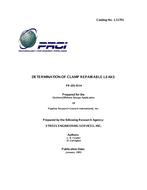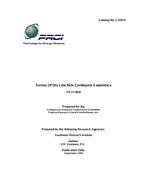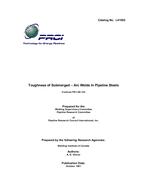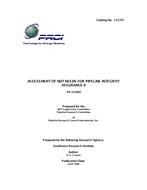Provide PDF Format
PRCI PR-201-9114
- Determination of Clamp Repairable Leaks
- Report / Survey by Pipeline Research Council International, 01/01/1993
- Publisher: PRCI
$148.00$295.00
L51701e
Stress Engineering Services, Inc.
Need: Once a leak in a subsea pipeline has been located, there are several methods available to deal with it. These range in cost and difficulty from relaying the line to clamping. Clamping is obviously the quickest and least expensive method. However, there are not clear guidelines as to where clamp repair is applicable.
Benefit: The object of this project is to explore the limits of a dent which may be sealed by a clamp. This is to determine whether or not a particular dent can be sealed by the prototype clamp. This work was done with the aid of non-linear finite element analysis of a typical rubber seal using the ABAQUS program. The effect of various pipe ovalities was investigated relative to the clamps ability to provide active circumferential seal pressure. It was shown that initially the clamp circumferential seals gradually built hydrostatic pressure due to gland loading until the rubber traversed the gap distance between the clamp and pipe. Then the contact pressure increased at a rapid linear rate as the glands were tightened further.
Result: Reliable seals will require that the end circumferential seals be independently activated from the longitudinal seals. The reason for this is that seals which do not have a required force may not develop adequate sealing pressure. With independent circumferential and longitudinal seals hand calculations are adequate to design the seals. Deep pits however may be a problem. This is not a problem that is readily tractable analytically. It is recommended that if a deep pit is encountered, that sealability be verified by a field simulation using an artificially created defect immediately before the clamp is installed. It appears that ovality that occurs within the confines of pipe allowables should be acceptable. The suggested guidelines for acceptability of clamp repair are as follows: A. The pipeline must not be dented to such a degree that pigs can no longer pass. B. The pipeline must not have structural damage to the extent that a split clamp will no longer fit around the pipeline. C. The ovality of the pipeline where the split clamp is to seal against must be within the limits set by the clamp manufacturer which are generally based on API pipe tolerances. D. Most small weld defects away from flanges, valves, etc. are usually clamp repairable.
Stress Engineering Services, Inc.
Need: Once a leak in a subsea pipeline has been located, there are several methods available to deal with it. These range in cost and difficulty from relaying the line to clamping. Clamping is obviously the quickest and least expensive method. However, there are not clear guidelines as to where clamp repair is applicable.
Benefit: The object of this project is to explore the limits of a dent which may be sealed by a clamp. This is to determine whether or not a particular dent can be sealed by the prototype clamp. This work was done with the aid of non-linear finite element analysis of a typical rubber seal using the ABAQUS program. The effect of various pipe ovalities was investigated relative to the clamps ability to provide active circumferential seal pressure. It was shown that initially the clamp circumferential seals gradually built hydrostatic pressure due to gland loading until the rubber traversed the gap distance between the clamp and pipe. Then the contact pressure increased at a rapid linear rate as the glands were tightened further.
Result: Reliable seals will require that the end circumferential seals be independently activated from the longitudinal seals. The reason for this is that seals which do not have a required force may not develop adequate sealing pressure. With independent circumferential and longitudinal seals hand calculations are adequate to design the seals. Deep pits however may be a problem. This is not a problem that is readily tractable analytically. It is recommended that if a deep pit is encountered, that sealability be verified by a field simulation using an artificially created defect immediately before the clamp is installed. It appears that ovality that occurs within the confines of pipe allowables should be acceptable. The suggested guidelines for acceptability of clamp repair are as follows: A. The pipeline must not be dented to such a degree that pigs can no longer pass. B. The pipeline must not have structural damage to the extent that a split clamp will no longer fit around the pipeline. C. The ovality of the pipeline where the split clamp is to seal against must be within the limits set by the clamp manufacturer which are generally based on API pipe tolerances. D. Most small weld defects away from flanges, valves, etc. are usually clamp repairable.
Related Products
PRCI PR-003-9420
Evaluation of Circumferential Magnetic Flux for In-Line Detection of Stress Corrosion Cracks and Sel..
$198.00 $395.00





